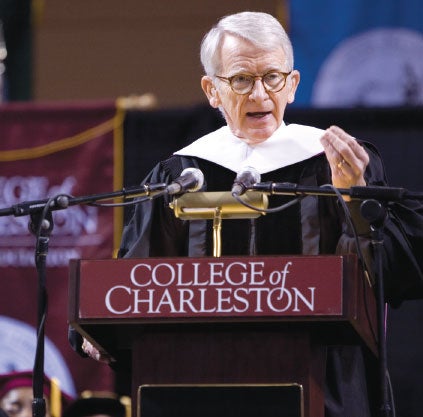 Over the four decades that Joe Riley served as mayor of Charleston, he had a hand in shaping virtually every facet of life in the Holy City. Under his guidance and leadership, Charleston has become an international tourism destination, a hub of culture and the arts, an economic powerhouse and a model for historic preservation and urban design. As the city has grown and prospered, so, too, has the College.
Over the four decades that Joe Riley served as mayor of Charleston, he had a hand in shaping virtually every facet of life in the Holy City. Under his guidance and leadership, Charleston has become an international tourism destination, a hub of culture and the arts, an economic powerhouse and a model for historic preservation and urban design. As the city has grown and prospered, so, too, has the College.
Launching Spoleto in the Cistern Yard
Mayor Riley has said that if not for former College of Charleston President Ted Stern (1968–1978) and the resources of the College, Spoleto Festival USA would never have gotten off the ground. So it was fitting that Riley, Stern and others kicked off the opening ceremonies for the inaugural festival on May 25, 1977, in the College’s Cistern Yard. The College and the international festival have enjoyed a close and symbiotic relationship ever since.
“Spoleto Festival USA will be identified as Mayor Riley’s signature contribution to the arts in Charleston,” says Karen Chandler, director of the College’s arts management program, who notes that Riley was also actively involved in establishing Piccolo Spoleto and the MOJA Arts Festival as well as spearheading the renovation of the Gaillard Center and the proposed International African American Museum. “The history of American arts leadership has Mayor Riley’s name and cultural achievements written in its annals. Those of us who call Charleston home, and those who visit here, are all the better for his vision, tenacity and unparalleled leadership in the arts.”
Balancing Old and New
Among Riley’s most heralded achievements is the manner in which he sought to balance the needs and development of a growing city against the importance of preserving the city’s historic homes and buildings and architectural significance.
While the College is a caretaker for numerous historic and modern structures, three campus buildings speak to Riley’s legacy in the area of preservation and urban design.
Marlene and Nathan Addlestone Library: Mayor Riley spoke at the dedication ceremony for the library in March 2000, recognizing its importance for the campus and Charleston.
Riley Center: This campus building will always be associated with the former mayor. The Joseph P. Riley Jr. Center for Livable Communities is part of the College’s Department of Political Science and is focused on enhancing community life in the Charleston area. Established in 1978 as the Center for Metropolitan Affairs, the center was renamed for Riley in 2001.
Randolph Hall: Riley often visited this National Historic Landmark for College and community commitments. In fact, the building inspired the design of one of Riley’s crowning building achievements as mayor: The $142-million Gaillard Center features a neoclassical design intended to mimic the College’s Randolph Hall, with both structures serving as anchors on their respective ends of George Street.
“It is impossible to introduce the concept of historic preservation in America without discussing Charleston and the impact that Mayor Riley has had on the preservation community – locally, regionally, nationally and even internationally,” says R. Grant Gilmore, director of the College’s historic preservation program. “Riley’s vision for the City of Charleston has provided the most successful example to date for an unrivaled combination of urban planning/design and historic preservation in the U.S.”




